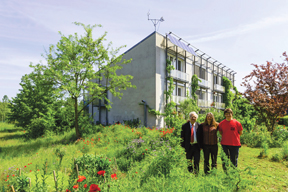
June 2021
Dear EarthTalk: What is a so-called “passive solar” house and can I retrofit my existing house accordingly? ~ Bill C., Raleigh, NC
A passive solar house is typically designed from scratch factoring in several considerations to boost the structure’s ability to naturally keep the interior living spaces a comfortable air temperature without using conventional emissions-spewing HVAC appliances.
The concept hinges on having lots of insulation, no air leaks, and large, strategically-oriented south-facing windows that “collect” heat energy (in the form of sunlight) during the day and store it in “thermal mass” (concrete slabs, brick walls, tile floors or other building materials with heat retention capacity). This stored solar energy is then naturally distributed throughout the interior space by natural convection caused by ventilation and the dynamics of colder and warmer air reacting differently to gravity.
While the concept has been kicking around since at least the 1950s, it wasn’t until 1991 that Dr. Wolfgang Feist, an Austrian physicist and subsequent founder of the Passivhaus Institut, turned the dream into a reality with the design and construction of the world’s first passive solar house in Darmstadt, Germany.

This three-story home was designed from the ground up with thick walls and copious amounts of efficient insulation, and no holes large or small where hot air could escape. The Feist house was also designed to be free of any potential “thermal bridges,” where heat could travel through walls to get outside, unlike conventional homes which are framed with wood 2x4s and 4x4s with insulation laid or sprayed in between. Conventional framing typically comprises about 25 percent of the interior walls’ surface area. Unlike the insulation around it, the framing sections provide zero insulation value and therefore act as thermal bridges whereby hot air can escape. Passive houses, on the other hand, are designed with solid slabs or with denser framing materials to cut off this insidious form of heat loss.
Siting is also a major design consideration for any passive solar house. Picking a spot that can harvest lots of sunlight (via large south-facing triple-glazed windows) and also take advantage of neighboring shade (like large trees and buildings) to cool the structure off in the heat of summer is also key. Indeed, it is of paramount importance to the building’s success in maintaining consistently comfortable indoor air temperatures without electricity or gas/oil no matter the weather outside. Another important aspect of the passive solar design is the incorporation of some kind of heat recovery ventilation (HRV) system that can let fresh air into the building without letting any of the heat out.
Given all of the design, siting and construction factors involved, it’s usually not practical to convert a pre-existing conventional house into a passive solar one. But that said, there’s no reason not to upgrade what you can at home to at least take advantage of increased efficiencies where it’s easy and get as close to passive solar as possible. Upgrade your insulation. Plug holes and other air leaks. Put weather-stripping around doors and windows. The list goes on… While you might not be able to do any and everything to make your house greener, remember that a walk of 100 miles starts with one step.
CONTACTS:
Passive House Institute, www.passivehouse.com;
Passive House Accelerator, www.passivehouseaccelerator.com;
International Passive House Association, www.passivehouse-international.org
Dear EarthTalk: What’s the latest on hydrogen powered fuel cells? Not long ago they were touted as the energy source of the future, but news has been scant of late. ~ J. Gorman, Columbia, SC
Indeed, around the turn of the millennium, the development of hydrogen fuel cells to power our transportation sector with renewable, non-polluting power was all the rage among environmentalists and techies alike. Fuel cells combine hydrogen and oxygen via an electrochemical reaction to make electricity, with water as the only “exhaust.” The first crude fuel cells were invented in England in the 1830s, but the technology really gained momentum in the 1960s when NASA developed them for the space program.
Unlike traditional batteries, which need to be regularly recharged, fuel cells operate continuously as long as they have a steady supply of oxygen and hydrogen. Oxygen is available anywhere and anytime from the air around us. Hydrogen, though also one of the planet’s most common elements, isn’t easily separated from the compound molecules it is usually part of. So, either gasification or electrolysis are used to separate the hydrogen out. But this requires copious amounts of energy, which is most often derived from fossil fuel sources, calling into question just how sustainable fuel cells actually may be.
Start-ups working on fuel cells for the auto industry (Ballard Power, Plug Power) became the darlings of investors in the 1990s and 2000s, but in the intervening two decades hybrids and EVs started to take over the auto sector instead of cars powered by hydrogen, and fuel cell makers shifted most of their attention to the aviation industry. So, what happened? Why aren’t we all driving around in fuel cell cars today?

One major hurdle was the lack of a refueling infrastructure. Internal combustion cars and trucks (and hybrids) can get gasoline at just about every other corner and highway exit across the country. Meanwhile, EV drivers just need an electrical outlet, one of the most ubiquitous pieces of “infrastructure” in our world, to recharge their cars’ batteries for the next 80-200 miles.
But if you do happen to drive one of the 300 fuel cell vehicles sold (or leased) in the U.S. in recent years—Toyota Mirai or Honda Clarity, to name a few, you’ll have to find a hydrogen refueling station to keep the road trip alive. And if you don’t live in California, home to 43 of the nation’s 48 hydrogen refueling stations thanks to the forward-looking state’s Clean Transportation Program, a fuel cell vehicle probably doesn’t make a lot of sense.
While fuel cells may not have lived up to their initial hype as the future of the automotive transportation sector, they are playing an increasingly larger role in powering various aspects of the aviation and aerospace industries, where hydrogen production and refueling operations can be relatively centralized. Another growth area for fuel cells is stationary applications. Our existing natural gas distribution system could be modified to pipe hydrogen into our buildings to feed fuel cells to take care of our energy needs. While fuel cells alone may not be the answer to our environmental problems, they are proving to be one of the arrows in the quiver of those trying to be part of the solution.
CONTACTS:
Fuel Cell Basics, www.fchea.org/fuelcells;
“Why We Still Can’t Deliver on the Promise of Hydrogen Cars,” www.thedrive.com/tech/33408/why-we-still-cant-deliver-on-the-promise-of-hydrogen-cars;
“Hydrogen Fuel is Getting Buzz, But Here’s Why It Hasn’t Gone Mainstream,” www.news.usc.edu/trojan-family/why-hydrogen-fuel-isnt-mainstream-as-fossil-fuel-alternative/;
“What Ever Happened To Fuel Cells?” www.powermag.com/whatever-happened-to-fuel-cells/
EarthTalk® is produced by Roddy Scheer & Doug Moss for the 501(c)3 EarthTalk.
See more at https://emagazine.com. To donate, visit https://earthtalk.org.
Send questions to: question@earthtalk.org

